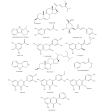Russian olive (Elaeagnus angustifolia) as a herbal healer
- PMID: 27853679
- PMCID: PMC5108988
- DOI: 10.15171/bi.2016.22
Russian olive (Elaeagnus angustifolia) as a herbal healer
Abstract
Introduction:Elaeagnus spp. is one in the family of riparian trees growing near the rivers or water corridors. In this family, Elaeagnus angustifolia (Russian olive) is famous because of its medical applications. Methods: A comprehensive review was performed to extract the related data from published literature. Results: Traditionally, it has been used as an analgesic, antipyretic and diuretic herbal medicine. A large number of compounds have been derived from Russian olive and made this plant a source of flavonoids, alkaloids, minerals and vitamins. Although the purpose of most studies is to use this plant for preparation of herbal medicines and as an ingredient for drug formulation, there is no available drug dosage form commercially. Conclusion: This review aimed to provide the most important documentary information on the active components of Elaeagnus spp. and their relation to the pharmacological properties and compare them with reported medicinal effects.
Keywords: Elaeagnus angustifolia; Flavonoid; Inflammation; Russian olive; Traditional remedy.
Similar articles
-
Russian olive (Elaeagnus angustifolia L.): From a variety of traditional medicinal applications to its novel roles as active antioxidant, anti-inflammatory, anti-mutagenic and analgesic agent.J Tradit Complement Med. 2016 Feb 16;7(1):24-29. doi: 10.1016/j.jtcme.2015.09.004. eCollection 2017 Jan. J Tradit Complement Med. 2016. PMID: 28053884 Free PMC article. Review.
-
A comprehensive review on phytochemical and pharmacological aspects of Elaeagnus angustifolia L.J Pharm Pharmacol. 2015 Nov;67(11):1467-80. doi: 10.1111/jphp.12442. Epub 2015 Jun 16. J Pharm Pharmacol. 2015. PMID: 26076872 Review.
-
Germination and Establishment of the Native Plains Cottonwood (Populus deltoides Marshall subsp. monilifera) and the Exotic Russian-olive (Elaeagnus angustifolia L.).Conserv Biol. 1995 Oct;9(5):1169-1175. doi: 10.1046/j.1523-1739.1995.9051159.x-i1. Conserv Biol. 1995. PMID: 34261252
-
Phytochemistry and Phytotherapeutic Aspects of Elaeagnus angustifolia L.Curr Drug Discov Technol. 2016;13(4):199-210. doi: 10.2174/1570163813666160905115325. Curr Drug Discov Technol. 2016. PMID: 27593387 Review.
-
Decomposition of leaf litter from a native tree and an actinorhizal invasive across riparian habitats.Ecol Appl. 2009 Jul;19(5):1135-46. doi: 10.1890/08-0294.1. Ecol Appl. 2009. PMID: 19688922
Cited by
-
Elaeagnus angustifolia Plant Extract Induces Apoptosis via P53 and Signal Transducer and Activator of Transcription 3 Signaling Pathways in Triple-Negative Breast Cancer Cells.Front Nutr. 2022 Mar 18;9:871667. doi: 10.3389/fnut.2022.871667. eCollection 2022. Front Nutr. 2022. PMID: 35369073 Free PMC article.
-
Phytocomplex Characterization and Biological Evaluation of Powdered Fruits and Leaves from Elaeagnus angustifolia.Molecules. 2020 Apr 26;25(9):2021. doi: 10.3390/molecules25092021. Molecules. 2020. PMID: 32357533 Free PMC article.
-
Interactions at the Oviposition Scar: Molecular and Metabolic Insights into Elaeagnus angustifolia's Resistance Response to Anoplophora glabripennis.Int J Mol Sci. 2024 Aug 31;25(17):9504. doi: 10.3390/ijms25179504. Int J Mol Sci. 2024. PMID: 39273453 Free PMC article.
-
An Experimental Study on the Mechanical and Biological Properties of Bio-Printed Alginate/Halloysite Nanotube/Methylcellulose/Russian Olive-Based Scaffolds.Adv Pharm Bull. 2018 Nov;8(4):643-655. doi: 10.15171/apb.2018.073. Epub 2018 Nov 29. Adv Pharm Bull. 2018. PMID: 30607337 Free PMC article.
-
Medicinal herbs in the treatment of neuropathic pain: a review.Iran J Basic Med Sci. 2018 Apr;21(4):347-358. doi: 10.22038/IJBMS.2018.24026.6021. Iran J Basic Med Sci. 2018. PMID: 29796216 Free PMC article. Review.
References
-
- Mineau MM, Baxter GV, Marcarelli AM, Minshall GW. An invasive riparian tree reduces stream ecosystem efficiency via a recalcitrant organic matter subsidy. Ecology. 2012;93:1501–8. - PubMed
-
- Mehrabani Natanzi M, Pasalar P, Kamalinejad M, Dehpour AR, Tavangar SM, Sharifi R. et al. Effect of aqueous extract of Elaeagnus angustifolia fruit on experimental cutaneous wound healing in rats. Acta Med Iran. 2012;50:589–96. - PubMed
-
- Huang Z, Liu M, Chen B, Uriankhai T, Xu C, Zhang M. Distribution and interspecific correlation of root biomass density in an arid Elaeagnus angustifolia–Achnatherum splendens community. Acta Ecolo Sin. 2010;30:45–9. doi: 10.1016/j.chnaes.2009.12.008. - DOI
Publication types
LinkOut - more resources
Full Text Sources
Other Literature Sources
Miscellaneous





